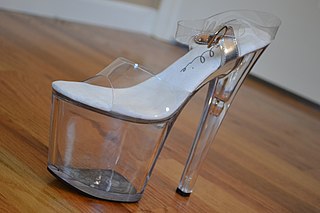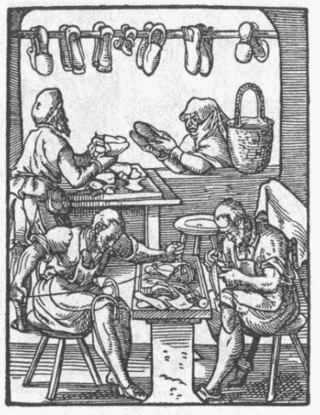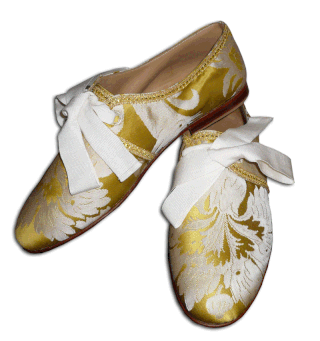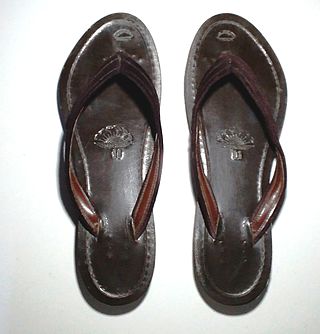
A shoe is an item of footwear intended to protect and comfort the human foot. Though the human foot can adapt to varied terrains and climate conditions, it is vulnerable, and shoes provide protection. Form was originally tied to function but over time shoes also became fashion items. Some shoes are worn as safety equipment, such as steel-toe boots, which are required footwear at industrial worksites.

Footwear refers to garments worn on the feet, which typically serve the purpose of protection against adversities of the environment such as wear from rough ground; stability on slippery ground; and temperature.

Clogs are a type of footwear made in part or completely from wood. Used in many parts of the world, their forms can vary by culture, but often remained unchanged for centuries within a culture.

Slippers are a type of shoes falling under the broader category of light footwear, that are easy to put on and off and are intended to be worn indoors, particularly at home. They provide comfort and protection for the feet when walking indoors.

Flip-flops are a type of light sandal-like shoe, typically worn as a form of casual footwear. They consist of a flat sole held loosely on the foot by a Y-shaped strap known as a toe thong that passes between the first and second toes and around both sides of the foot. This style of footwear has been worn by the people of many cultures throughout the world, originating as early as the ancient Egyptians in 1,500 B.C. In the United States the modern flip-flop may have had its design taken from the traditional Japanese zōri, after World War II as soldiers brought them back from Japan.

Zori, also rendered as zōri, are thonged Japanese sandals made of rice straw, cloth, lacquered wood, leather, rubber, or—most commonly and informally—synthetic materials. They are a slip-on descendant of the tied-on waraji sandal.

Geta (下駄) are traditional Japanese footwear resembling flip-flops. A kind of sandal, geta have a flat wooden base elevated with up to three "teeth", held on the foot with a fabric thong, which keeps the foot raised above the ground.

Espadrilles are casual, rope-soled, flat but sometimes high-heeled shoes. They usually have a canvas or cotton fabric upper and a flexible sole made of esparto rope. The esparto rope sole is the defining characteristic of an espadrille; the uppers vary widely in style.

Platform shoes are shoes, boots, or sandals with a thick sole, usually in the range of 3–10 cm (1–4 in). Platform shoes may also be high heels, in which case the heel is raised significantly higher than the ball of the foot. Extreme heights, of both the sole and heel, can be found in fetish footwear such as ballet boots, where the sole may be up to 20 cm (8 in) high and the heels up to 40 cm (16 in) or more. The sole of a platform shoe can have a continuous uniform thickness, have a wedge, a separate block or a stiletto heel. Raising the ankle increases the risk of a sprained ankle.

Sandals are an open type of shoe, consisting of a sole held to the wearer's foot by straps going over the instep and around the ankle. Sandals can also have a heel. While the distinction between sandals and other types of footwear can sometimes be blurry, the common understanding is that a sandal leaves all or most of the foot exposed. People may choose to wear sandals for several reasons, among them comfort in warm weather, economy, and as a fashion choice. Usually, people wear sandals in warmer climates or during warmer parts of the year in order to keep their feet cool and dry. The risk of developing athlete's foot is lower than with enclosed shoes, and the wearing of sandals may be part of the treatment regimen for such an infection.

Shoemaking is the process of making footwear.

Slides or sliders are a type of light footwear that are characterized by having a loose heel that holds on to the foot from the front. Like flip-flops, they are typically employed in casual situations, in addition to being a unisex footgear worn by both sexes. Sliders are distinguished from flip-flops by their vamp strap which does not separate the big toe from the rest of the toes.

Opanci are traditional peasant shoes worn in Southeastern Europe. The attributes of the opanci are a construction of leather, lack of laces, durable, and various endings on toes. In Serbia, the design of the horn-like ending on toes indicates the region of origin, though this specific design is not exclusive to Serbia. The opanci are also considered as the traditional peasant footwear for people in the Balkan region. In Bulgaria they are referred to as "tsarvuli".

Episcopal sandals, also known as pontifical sandals, are a Catholic pontifical vestment worn by bishops when celebrating liturgical functions according to the pre–Vatican II rubrics, for example a Tridentine Solemn Pontifical Mass.

A dress shoe is a shoe to be worn at smart casual or more formal events. A dress shoe is typically contrasted to an athletic shoe.

Ballet flats are women's shoes for everyday wear which are similar to/inspired by a women's ballet shoes, with a very thin heel or the appearance of no heel at all. The style sometimes features a ribbon-like binding around the low tops of the slipper and may have a slight gathering at the top-front of the vamp and sometimes a tiny, decorative string tie. Ballet slippers can be adjusted and tightened to the wearer's foot by means of this string tie.

Hnyat-phanat is a Burmese traditional sandal, similar to flip-flops. Although it refers to almost any sandal worn by the people of Myanmar, it is mostly used to refer to the traditional Mandalay velvet slippers that originate in Upper Burma (Myanmar).

Source Sandals, known in Hebrew as Shoresh Sandals, are outdoor, trekking and hiking sandals marketed as having a "Non-Slip sole even in wet conditions" and a typical patented x-strap-design. They have a strong tradition especially in the world of backpackers. They are manufactured in Tirat Carmel in northern Israel and sold all over the world.

The calceus was the common upper-class male footwear of the Roman Republic and Empire. Normally made of leather and hobnailed, it was flat soled and typically reached the lower shin, entirely covering the foot and ankle. It was secured with crossed thongs or laces. Equivalent to a short boot or high-top shoe, it was lighter than the military caliga but sturdier than slip-on shoes like the soccus and able to easily handle outdoor use.



















